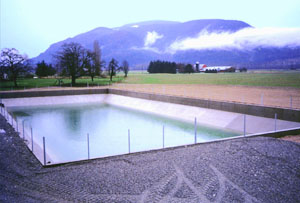Action Plan for Nutrient Management Underway
The following article is an excerpt from Growing Together newsletter – Winter 2000 issue …….

Increased manure storage assists nutrient management planning.
The Lower Fraser Valley is an important area of commercial agricultural production, representing a wide diversity of commodities that contribute a majority of BC’s farm cash receipts. The agriculture industry is the mainstay of many communities in this region of the province. One of the major considerations in all Fraser Valley farming operations, regardless of size or commodity produced, should be the appropriate management of the farm’s nutrients.
Agriculture organizations are working proactively with government ministries and agencies to develop a Nutrient Management Action Plan (NMAP) for the Fraser Valley. Through the Agriculture Environment Partnership Committee it was agreed the Fraser Basin Council ould facilitate this process.
The development of this plan is being undertaken in response to a series of reports on the Management of Livestock and Poultry Manures in the Lower Fraser Valley 1994-97. Reports 1-9 and as a result of the recognition that there are issues to address. In some areas of the Lower Fraser Valley large nutrient surpluses are resulting in water quality problems that affect both downstream producers, and key populations of coho and chum salmon, and cutthroat trout. While the reports provide an overview of the challenges and opportunities, there is a need for a plan detailing how opportunities to address the issue can be acted upon. The intent of the process is to define the priority actions, the roles and responsibilities of government agencies and agricultural interests, and a timeline for implementation.
The agriculture industry agrees that a proactive and cooperative approach is required, emphasizing that producers must play a key role in developing and implementing the actions, building on many positive initiatives that are already underway and the progress that has been made already. This includes:
- Manure Management Guidelines for all sectors of the industry
- Agriculture Peer Advisory Services
- Sustainable Poultry Farming Group Manure Transportation
- Hog Industry Transition Plan
- Increased Manure Storage Capacity (Investment Agriculture Foundation program)
Steve Thomson, Coordinator for the BC Agriculture Council noted, “the industry has made significant progress in addressing nutrient issues. For example manure storage capacity has increased in the past few years and continues to expand, manure management guidelines have been prepared in consultation with commodity groups and have been promoted by them, and we have moved significant quantities of poultry manure out of identified sensitive areas.”
The process has three objectives. They are to:
- Address areas where estimated nutrient budgets far exceed the capacity of the land or crop
- Reduce agriculture sources of pollution to water and land, through the adoption of on-farm nutrient management practices, in areas where there is sufficient land to assimilate nutrient production
- Through planning, avoid future imbalances in the amount of nutrients applied to agricultural lands.
“From the perspective of the Fraser Basin Council, we see that farmers want to be more recognized as good stewards of the environment and be economically viable. At the same time, we see that government agencies want measurable progress in addressing issues such as water quality and fish habitat. The Fraser Basin Council believes that farmers and government can build a plan that will help in achieving all of these objectives. The council is pleased to be working with farmers and government to help in this important work,” said Iona Campagnola, Chair of the Fraser Basin Council.
Collectively, government agencies and agriculture interests have many of the tools that are needed to manage agricultural nutrients in a more sustainable way. The cooperative approach can strengthen those tools and can provide benefits for agricultural and community interests, while helping the both the environment and the local economy.

